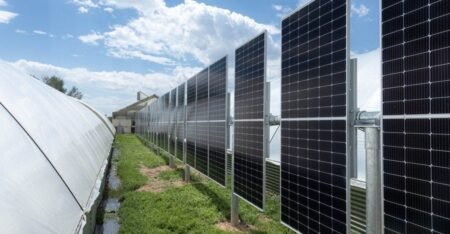On board China’s high-speed rail network, travelling at more than 200 kilometres per hour, David Fishman knew that he had arrived in Shandong province when he saw a field of dark, glimmering rooftops from the train window. Fishman, an energy analyst at the Lantau Group, an economic consultancy firm in Shanghai, was keen to meet with developers in Shandong to understand how China is developing extensive rooftop solar installations at such a remarkable pace. Shandong is leading China’s rooftop solar-development initiatives, accounting for 18% of such projects across the country. As of March, the province had installed 33 gigawatts (GW) of distributed solar capacity, enough to power an estimated 18 million homes.
Boasting several of the largest photovoltaic stations ever built, China is the world’s top solar-energy producer. Most of its solar farms are located in its western regions, where land and sunlight are abundant, but much of the country’s energy demand comes from more economically developed and densely populated regions in the east, such as Shandong. Currently, many of China’s eastern regions rely on power generated and transmitted from the west.
In recent years, China has shifted its focus from centralized solar farms to smaller-scale distributed solar projects, as photovoltaic research continues to improve the technology and lower its costs. Such research, and other areas related to tackling climate change and pollution, is helping Chinese science cities to make rapid gains in the Nature Index (see ‘Leading lights’), especially in Earth and environmental sciences (see ‘Laser focus’).
Unlike large solar farms, distributed photovoltaic systems — often built on rooftops — are intended to generate power for local use. Electricity generated through photovoltaic panels can be consumed on-site by houses and factories, for example, or loaded onto the local grid to be distributed throughout the region. “If you want to vigorously develop renewable energy in the eastern part of the country, where land resources are very scarce, then these rooftops are a good resource,” says Min Yuan, a Beijing-based energy-transition project manager at the World Resources Institute, a non-profit research organization.
To boost rooftop solar development and increase local production of clean energy, the Chinese government rolled out its Whole County PV programme in 2021. So far, 676 counties in 31 provinces have signed up, most of which are located in the eastern half of the country. The programme encourages counties to build rooftop photovoltaic systems that cover at least 50% of government buildings, 40% of public buildings, such as schools and hospitals, 30% of commercial buildings and 20% of rural homes. Shandong leads, with 70 of its counties participating, followed by Henan province in central China and Jiangsu in the east.
These provinces have high electricity demands and rely heavily on coal power. By increasing the amount of clean energy generated through distributed solar projects, local governments hope to lower the cost of electricity while also contributing to China’s pledge to achieve carbon neutrality by 2060. At the same time, the Whole County PV programme provides an opportunity to revitalize rural China, local officials say. For example, homeowners can receive extra income by lending their rooftops to solar developers, or by selling the power generated by their rooftop system, Fishman says.
The plan seems to be working. Last year, China installed a record-breaking 87.4 GW of solar capacity, 59% more than in the previous year, according to China’s National Energy Administration. This takes the country’s total installed photovoltaic capacity to 392.6 GW. More than 51 GW of the new solar capacity was produced by distributed photovoltaic projects, nearly half of which came from panels mounted mainly on residential homes in rural areas. In total, by the end of 2022, China had built roughly 157 GW of distributed photovoltaic capacity, more than double that of the United States.
Second generation
China’s Whole County PV programme follows an earlier scheme that aimed to alleviate poverty in the country’s poorest villages using solar power. The Chinese government announced the Solar Energy for Poverty Alleviation Programme (SEPAP) in 2014, which pledged to increase the annual income of two million rural households by 3,000 yuan (US$410) each by 2020 through local distributed photovoltaic projects.
Tongwei county in northwestern China’s Gansu province was among the poverty-stricken areas that enrolled in SEPAP. Since 2015, the county has built 200 three-kilowatt photovoltaic systems for impoverished families, installing them on their rooftops, in their yards and in abandoned fields. According to local media, each system can generate as much as 9–12 kilowatt hours of electricity per day. By selling power to the local grid, households could earn 3,500 yuan each year.
Research is showing the impacts of distributed solar projects in rural China. Huiming Zhang, a renewable-energy economist at the Nanjing University of Information Science and Technology says that overall, SEPAP has been successful. According to China’s National Energy Administration, SEPAP has benefited more than 400 million people in impoverished households by adding roughly 26 GW of solar-power capacity through SEPAP by 2020, exceeding the initial goal of 10 GW.
But not all counties have seen the same level of growth in residents’ incomes as have those in Tongwei. Research by Zhang and his collaborators estimates that, between 2013 and 2016, SEPAP increased per-capita disposal income by only 7–8%, or household disposable annual income by 1,765 yuan, on the basis of data from 211 counties1. “While SEPAP certainly made a great contribution to poverty alleviation, the impact fell short of the initial target,” Zhang says.
Challenges remain
Suboptimal repair and maintenance of solar projects partially accounts for why revenues were lower than expected in some areas, says Yueming Qiu, an energy-policy researcher at the University of Maryland, College Park, and one of Zhang’s collaborators. Many of the photovoltaic stations built through SEPAP are in remote areas, and operators cannot always provide timely service if something breaks. “That lag in service could discourage villagers from reporting issues promptly,” Qiu says.
SEPAP-distributed solar projects were heavily subsidized by the government, and the costs could be as high as 30 billion yuan over five years. “In the future, we need to figure out ways to make these projects rely less on subsidies, maybe by developing it alongside other industries such as agriculture, so that we can alleviate poverty in a less costly way,” Qiu says. For example, some counties, including Tongwei, have been growing crops and raising livestock under a small array of photovoltaic panels, which provide shade while also generating power.
Selling power generated by rooftop solar panels to the grid does bring extra income to families. But solar-power supply surges at midday, when demand is low. This means that the grid would be buying the power at a cheap price, leaving solar generators with hardly any profits. Energy-storage devices, such as batteries, would help to alleviate the solar supply–demand mismatch, but they remain unaffordable for individual households.
International researchers such as Anders Hove, an energy-policy analyst at the Oxford Institute for Energy Studies, UK, propose a potential solution. He says that heat pumps — many of which use the same technology as air conditioners to provide both heat and cooling — could work as cheaper energy-storage systems for Chinese homes. In houses with insulation, heat from solar-powered pumps could be retained over a period of time, Hove says. His research shows that pairing heat pumps with rooftop solar panels in China could reduce household carbon emissions from heating by 90%, compared with clean coal stoves2. A popular device among rural families in China, these stoves burn coal that has been processed to release fewer pollutants, such as ash and sulfur. Besides heat pumps, Hove is exploring the potential of pairing China’s rooftop solar power with electric vehicles as another way to store excess energy for later use.
s the world’s largest energy consumer and carbon dioxide emitter, as well as its largest producer and consumer of coal, China faces high international pressure to quickly and markedly reduce its reliance on fossil fuels. Although coal-fired power generation has been declining since the mid-2000s, it still accounts for about 60% of the country’s total electricity generation. Fishman remains cautious about how much coal can realistically be replaced by solar projects, including those built through the Whole County PV programme. “Rooftop solar projects in eastern China allow these places to meet some of their renewable goals in the short term,” he says. But in future, when provinces need to achieve higher renewable-energy goals, they would still have to rely on clean power transmitted from northern and western China, which have more consistent sunlight, he says.
What is clear is that China needs to further increase the share of clean power in its energy structure to meet its carbon-reduction goals. “Solar power, whether in centralized or distributed forms, still needs to be developed as much as possible,” says Yuan.













1 Comment
Pingback: How China Became the World’s Leader on Renewable Energy - GreenBuildingAdvisor | baycalifornia